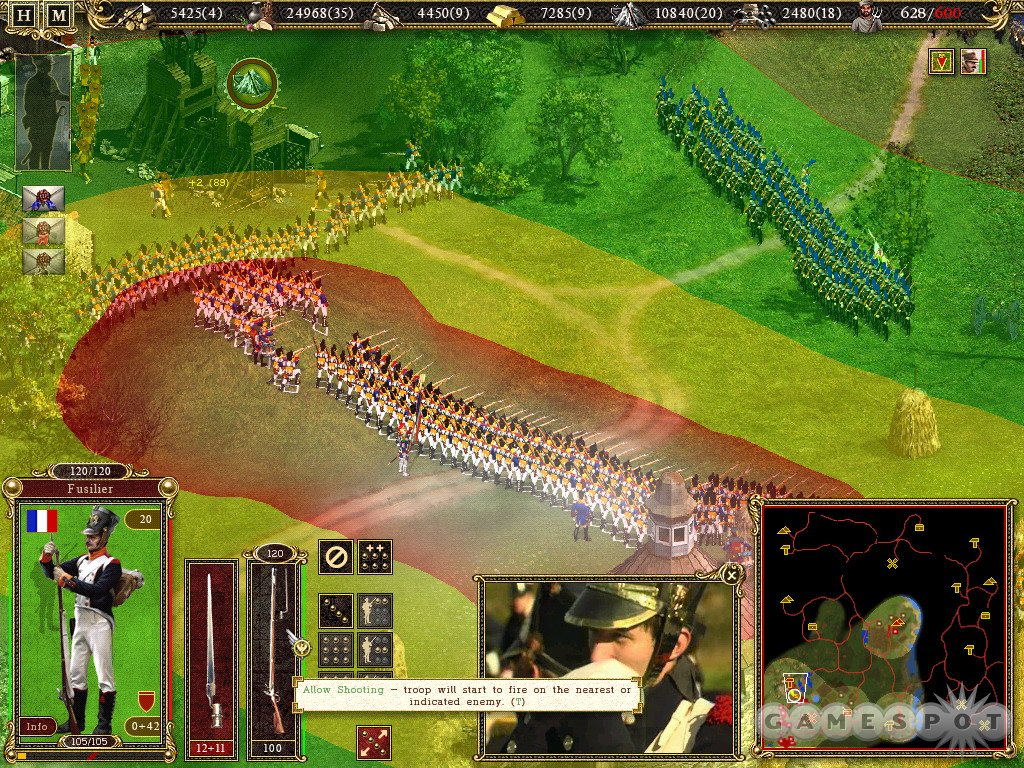Cossacks II: Napoleonic Wars, which came out in 2005, was an engaging strategy game that let you relive the pomp and circumstance that was Napoleonic combat. Huge formations of men stately marched around the countryside, only to be cut down by withering gunfire. There's actually much more to it than that, as the game abstracted the feeling of conquering entire swaths of the European countryside quite well. Cossacks II: Battle for Europe repackages that game and adds in some new content. But, at the heart of it, the experience is pretty much identical to that of last year's game. 
To be fair, Battle for Europe is a stand-alone expansion, which is how the developers managed to turn it around so quickly. So in addition to the content from Napoleonic Wars, Battle for Europe adds several new nations that you can play as, such as Spain and the Rhine Confederation. Aside from the new nations, Battle for Europe includes a slew of new missions and maps and some improved artificial intelligence. But when you get down to it, there aren't any significant game-changing new features or upgrades to the core game.
Like Napoleonic Wars, Battle for Europe offers several different game modes depending on your play style. The skirmish mode lets you battle it out in a number of historical battles, including Waterloo. Meanwhile, the battle mode is like a real-time strategy game, as you get to construct various buildings, gather different resources, and then raise regiments to go off and conquer villages on the map, which feed you more resources. Then there's the Battle for Europe mode (not to be confused with the game's name). This introduces the turn-based strategic layer that lets you conquer the map of Europe one province at a time, and this is mainly where you'll get to see the new nations in action. However, these new countries feel just like the older ones in many ways, and so their introduction doesn't do a lot to the overall game.
Still, Battle for Europe retains some of its interesting gameplay mechanics. For instance, the resource mechanic in Cossacks focuses on the old maxim that "professional soldiers study logistics." It's not enough to simply raise an army, but you've got to keep it fed and supplied with ammo. This is represented in the game by food and coal (gunpowder). The larger an army you have, the more of both resources you consume, so you must capture and defend important villages on the map, and then make sure that the supply lines are secure so that the pack mules can get to where they need to be.
Perhaps the most significant improvement is seen in the artificial intelligence. In the core game, the AI was content to throw regiments at you piecemeal, allowing you to shatter them rather easily. This time around, the AI seems more aware of that danger, and it's better about holding its troops beyond your effective firing range and trying to goad you into wasting your shot first. (In an era where it could take a minute to reload a rifle, firing early could often be fatal.) The AI also seems to be a bit better about flanking you, or using cavalry effectively. Once again, the game uses color-coded range circles to let you know when the enemy is in the "red" zone, which is close enough so you can see the whites of their eyes.

Multiplayer allows you to battle online in battle or skirmish mode, or in the ratings game, which lets you fight for your respective country in a persistent online game. The ratings mode divides the map of Europe into thousands of little territories, and each match that is fought decides the ownership of a territory. The multiplayer experience is pretty much identical to the single-player one, aside from the fact that you're battling a fellow human mind, rather than the AI. However, you may have latency issues, since it appears most of the game's player base is located in Europe.
Unfortunately, the translation issues that plagued Cossacks II also plague Battle for Europe. It's not a biggie, but it is annoying. The production values also remain unchanged, and while the 2D graphical style of the game seems appropriate for the setting (since it looks like paintings come to life at times), the synthesized, overly dramatic musical score is starting to wear thin at this point. Meanwhile, the recycled video clips showing Russian Napoleonic War reenactors are also a bit too familiar. And that pretty much sums up Battle for Europe. It's essentially Napoleonic Wars with a small amount of new content. There's not a lot here to recommend if you already own Napoleonic Wars, though if you are a newcomer to the series and have a yen for early 19th century warfare, you might want to give it a try.